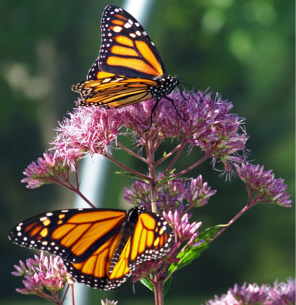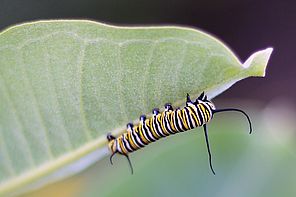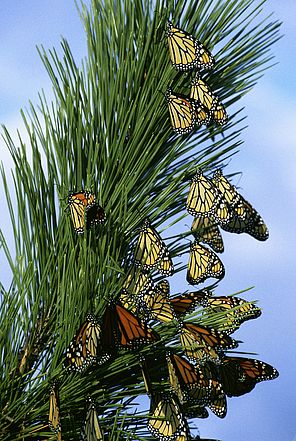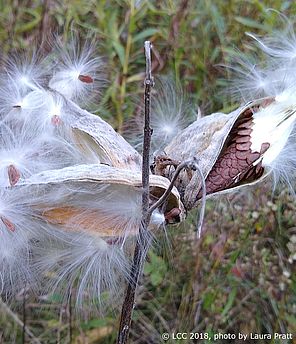Raising the Migration - Part I

Editor’s note: The Nature note below is written by Laura Pratt, LCC’s new ECO AmeriCorps Education & Outreach Coordinator. Laura’s service year with LCC began in mid-September and runs through early August 2019. She’ll be assisting us with a host of educational programs and writing about natural history and lake issues. <link learn news item lcc-welcomes-laura-pratt _blank internal link in current>(See the “New Face at LCC” section of this edition for more about Laura.) Read her piece below about raising monarchs, and stay tuned for a spring article about planting the right type of milkweed to help ensure their survival. Monarchs left the Lake Champlain watershed in September as temperatures dropped and the milkweed died back. Both factors drive their migration as they can’t survive low temperatures or reproduce without milkweed. Their destination? The oyamel fir forests north of Mexico City where all monarchs east of the Rocky Mountains migrate for winter. The butterflies that survived the journey from the Champlain Valley should be arriving in Mexico throughout November.
This past summer I worked as a gardener, traveling from house to house to weed, mulch, plant, and trim everything in sight. One of the unfortunate realities of gardening, however, is that sometimes I would have to weed out a native milkweed – tall, gangly, and painfully obvious in a row of petunias.
Milkweed is the only plant that monarch butterflies lay their eggs on, so it’s very important to their habitat. I tried to leave it alone when I could, but there were days when it was in the wrong place at the wrong time. I remember one particularly hot July afternoon I found one in a lily patch – and it already had two eggs on it.

They looked so vulnerable, clinging to leaves that were already wilting in the sun. As I looked at them I could imagine the butterflies they would become – friendly spots of orange-gold fluttering through the meadows, in colorful garden flowers and long highway grasses. They are the treasured official butterfly of seven states, including both Minnesota, where I came from, and Vermont, where I live now.
I decided to take the eggs home to try raising them myself. It was surprisingly easy, once I got started. The tiny white eggs, each smaller than a dandelion seed, hatched equally tiny caterpillars. As the caterpillars grew they ate more and more, and I had to scramble in the last few days to find enough milkweed for them. Their little jaws made a steady grinding sound as they ate – at first hardly audible, but steadily rising until I could hear it from across the room, like a far-off lawnmower. I loved watching them grow. Every morning I would eat breakfast by them at the windowsill, and every morning they were just a little bit bigger.
There’s a lot to learn whenever you’re raising a living thing, and as I added caterpillars to my terrarium I found myself googling increasingly esoteric questions. How long do monarch caterpillars take to grow? How do caterpillars make chrysalises? Do caterpillars feel pain? Do butterflies remember being caterpillars? What do I do when my caterpillar forms a chrysalis on the wall? It was like I had a bunch of tiny insect toddlers that were constantly at risk of wandering off, getting sick, and inadvertently eating each other. I loved it.

As summer stretched into August the monarch forums became increasingly active, murmuring about the coming great migration. Biology class had taught me that monarchs migrated, but I’d never considered how impossible that really was. The delicate eggs I brought in that month, which looked no different from the ones before, would grow up to fly almost 3,000 miles. On their own, these insects would be able to travel all the way from the sugar maples of Vermont to the oyamel fir trees of Mexico. On top of that, instead of living only long enough to lay eggs (four to six weeks), this generation of butterflies would live for six to eight months. In that time they would travel farther than some people ever get the chance to, following an inaudible signal further and further south.
Why do monarchs migrate? There are many theories. At its most fundamental migration is about survival – unlike other butterfly species, monarchs are unable to overwinter in their larval stage. When fall comes they need to make it to a warmer climate. Monarchs are able to ride the thermals down, covering 50-100 miles each day over a period of about two months. In the spring, when milkweed begins to bloom, the butterflies flock to it. Their children and grandchildren fly farther north with each successive generation, following the milkweed. It can take a full three to four generations for monarchs to return to the northern United States and Canada, where they settle in to repopulate for the next migration.

Not only does migration provide monarchs with the ideal balance of climate and habitat – it can also help the migrating population escape parasites that have built up over the summer. In particular, butterflies infected by the protozoan parasite Ophryocystis elektroscirrha, or OE, have difficulty flying long distances. When the migration comes they are left behind, and infection levels within the remaining population are kept low. This is a vast improvement over the year-round populations in Florida, where OE runs rampant. If you too decide to raise monarchs, please remember to use only the eggs you find in the wild. Companies that ship eggs and caterpillars for you to raise sometimes draw on highly infected populations, which spreads the parasite further.
Monarch butterflies are beautiful and mysterious, common and irreplaceable. They pollinate countless flowers and keep our ecosystems vital. They give us a sense that every life in this world, no matter how small, is part of something greater.
Keep an eye out for our upcoming spring article on monarch butterflies, with caterpillar-raising tips and gardening dos & don’ts!
